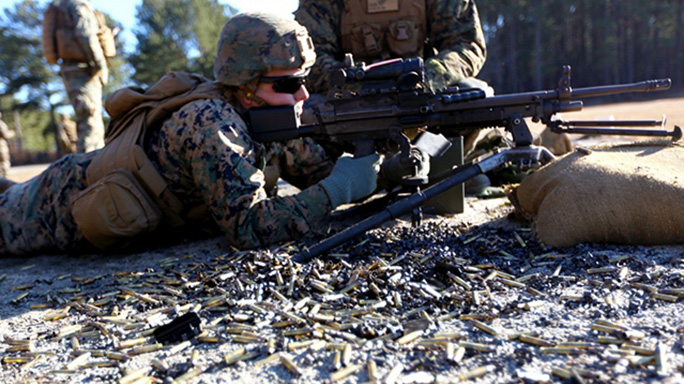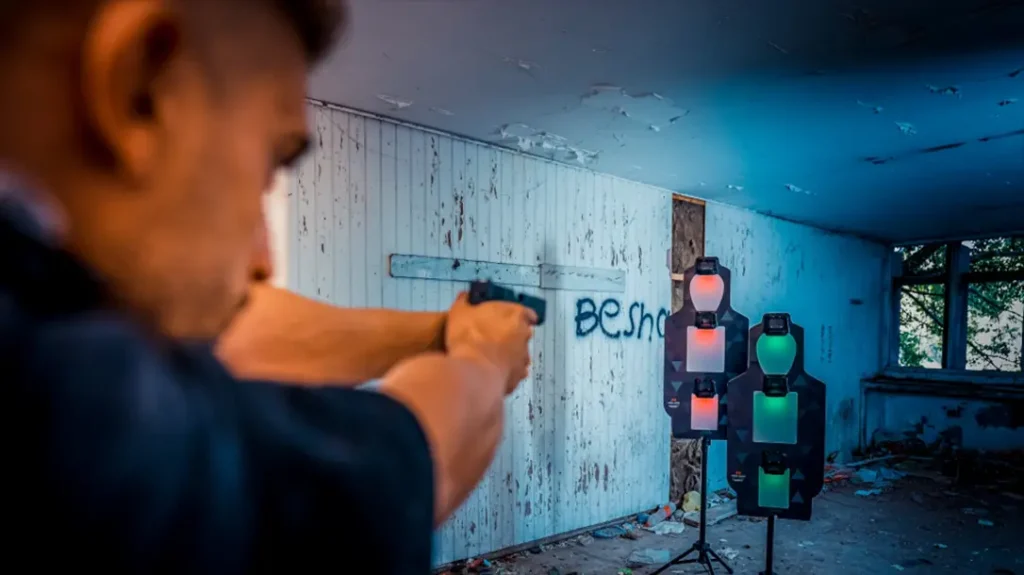The U.S. Army has posted a special notice announcing classified industry days for its Next Generation Squad Automatic Rifle, the intended replacement for the M249 Squad Automatic Weapon (SAW) in Brigade Combat Teams (BCT) and select support units over the next ten years. According to Soldier Systems, the industry days will take place July 25-27, 2017 at Fort Benning. Contractors who want to participate have until June 23, 2017 to submit the names of all attendees.
- RELATED STORY: US Army Gives Updates on M3A1 MAAWS, LSAT, PSR, XM25 CDTE, XM17
- RELATED STORY: US Army Issues RFI for 7.62 Interim Combat Service Rifle
Here are some of the general requirements for the Army’s Next Generation Squad Automatic Rifle, via FedBizOpps:
It will combine the firepower and range of a machine gun with the precision and ergonomics of a carbine, yielding capability improvements in accuracy, range, and lethality. The weapon will be lightweight and fire lightweight ammunition with improved lethality. The NGSAR will help to reduce the heavy load that burdens Soldiers and that has a significant negative impact on their mobility, survivability, and firing accuracy. Soldiers will employ the NGSAR against close and extended range targets in all terrains and conditions. The NGSAR will be compatible with and dependent on legacy optics and night vision devices to meet required capabilities. It will also be compatible with the Small Arms Fire Control system currently in development and possess back-up sights. It is anticipated the NGSAR support concept will be consistent with (comparable to) that of the predecessor M249 SAW involving the Army two level field and sustainment maintenance system. The NGSAR will achieve overmatch by killing stationary, and suppressing moving, threats out to 600 meters (T), and suppressing all threats to a range of 1200 meters (O).
Advertisement — Continue Reading Below
The FedBizOpps notice also lists a slew of “Mandatory Key Performance Parameters (KPP)” meant to identify the system capabilities for the Next Generation Squad Automatic Rifle. These KPPs, the Army says, are critical to the “development and improvement of an effective military capability that will make a significant contribution to the characteristics of the future joint force.”
KPP 1 System Survivability:
The NGSAR is a mission critical system that must be survivable to chemical, biological, radiological, nuclear (CBRN) exposure to include effects of electromagnetic pulse and cyber-attacks. The NGSAR must be operational after exposure to chemical, biological, radiological, and cyber-attack (T). The NGSAR must be operational after exposure to chemical, biological, radiological, nuclear, cyber threats and electromagnetic pulse (O).KPP 2 Operator System Training:
Soldiers will be trained to comply with the accuracy requirements in this document under simulated combat stressful conditions. Training on the system will be standards-based, leveraging technology in system design to minimize the training time and resources needed for operators/maintainers to achieve system competency. The following criteria will help to ensure system trainability:
1. TASK STEPS: 85% (T) to 95% (O) of tasks to operate and maintain the system will require less than 10 steps (including sub steps).
2. JOB/MEMORY AIDS: 85% (T) to 95% (O) of tasks that require 10 or more steps (including sub steps) will have job/memory aids that provide written procedures or diagrams to enable operators to perform the tasks without the need for extensive memorization.
3. MEMORIZATION: No more than 8 (T) and preferably 3 or less (O) discrete facts, terms names, rules, or ideas will be required to be memorized on any system task.
4. Instrumentable Multiple Integrated Laser Engagement System (I-MILES) Small Arms Transmitter (SAT) Tactical Engagement System (TES) Small Arms Transmitter (SAT). The NGSAR sight system must not interfere with the design, installation, or operation of the current I-MILES SAT and future Army-Tactical Engagement Simulation System (A-TESS) SATs when installed for Live Force-on-Force training.Advertisement — Continue Reading Below
KPP 3 Accuracy:
The NGSAR will have the capability to provide the P(i) metrics on the target sets located in the classified annex. This will require accurate P(h) along with ammunition capability.KPP 4 System Weight:
The NGSAR combat configured weapon including sling, bipod and sound suppressor will weigh no more than 12 pounds (T) 8 pounds (O). This does not include ammunition or magazine.KPP 5 Ammunition Weight:
The NGSAR ammunition will weigh 20 percent less than tactical brass equivalent caliber ammunition (T) 50% (O). Note the NGSAR ammunition could be a caliber not currently in use by the US Army. In that case the equivalent weights will be calculated through interpolation by the USG.Advertisement — Continue Reading Below
The notice also describes “Key System Attributes (KSAs)” which are “essential to achieving a balanced solution/approach to a system, but not critical enough to be designated a KPP.”
KSA 1 Sustainment:
1. Operational Availability (AO): The NGSAR at the system level will be no less than 94.2% (T), 95.1% (O) measured over an extended period of operations consistent with (and indicative of) the annual wartime system usage cycle.
2. Reliability: The NGSAR will be functional in all operational environments (hot, basic, cold, severe, extreme sand/dust). Reliability of the NGSAR, measured at the system level (functions of weapon plus ammunition addressed collectively as an integrated capability) during equipment operation in accordance with wartime usage.
2.1 Class I (Immediately Operator Clearable) Failures: The NGSAR will demonstrate 94.5% (T), 99.3% (O) probability of successfully completing a day of wartime operations (daily average of 450 rounds fired per weapon) without incurring more than one immediately operator clearable (Class I) EFF as defined in the NGSAR Reliability FDSC (EFFs of Class I severity are clearable in 10 seconds or less).
2.2 Class II (Operator Clearable) Failures: The NGSAR will demonstrate not less than 90.1% (T), 99.2% (O) reliability of successfully completing each individual wartime mission specified in the OMS/MP (most demanding mission involves 293 rounds fired per weapon) without incurring a Class II operator clearable EFF (which requires more than 10 seconds to clear).
2.3 Class III (Non-Operator Clearable) Failures: The NGSAR will demonstrate not less than 90.6% (T), 92.0% (O) reliability of successfully completing the 72-hour wartime scenario specified in the OMS/MP (1,349 rounds fired per weapon) without incurring a non-operator clearable (Class III) EFF.
2.4 Barrel Life: The NGSAR will have a barrel life capable of meeting KPP accuracy/dispersion requirements with no more than a 10% degradation for 10,000 (T) and no degradation for 20,000 rounds (O).KSA 2 Total Ownership Cost (Weapon Only):
Intentionally left blank.Advertisement — Continue Reading Below
KSA 3 Size:
NGSAR will have a maximum length of 38 inches and no longer than 35 inches with the buttstock in the stowed configuration (T); 35 inches maximum length and no longer than 32 inches with the buttstock stowed (O).KSA 4 Rate of Fire:
NGSAR shall be capable of a rate of fire of 60 rounds per minute for 16 minutes and 40 seconds without a barrel change or risk of cook-off. Cyclic 200 rounds without cook off (T). NGSAR will be capable of 108 rounds per minute sustained for 9 minutes and 16 seconds without barrel change or risk of cook off. Cyclic 300 rounds without cook off (O).KSA 5 Controllability:
NGSAR shall enable the Soldier to maintain a clear sight picture during automatic fire engagement of moving targets from the prone position with bipod (T). NGSAR will allow the Soldier to maintain a clear sight picture during engagement of moving targets from the kneeling position (O). Low recoil will allow the Soldier to better control the weapon and remain on target improving probability of hit. Recoil energy limitations will be in accordance with Test Operations Procedure 3-2-045 and Table 1 of TOP 03-2-826A.Advertisement — Continue Reading Below
KSA 6 Firing Modes:
NGSAR will have the capability to fire in automatic and semi-automatic modes (T). NGSAR will be capable of firing two rounds with one trigger pull with both rounds impacting the target within 1 inch at 100 meters in automatic or semi-automatic modes (O).KSA 7 Weapon Signatures:
1. Suppressed sound signature at the shooter’s ear will be less than the suppressed M249 (T). The NGSAR will be unable to localize by sound beyond 300m (O). Localize is defined as the detection and subsequent identification of the weapon system, to include the type of weapon, and its location to the degree that an enemy could return effective fire on it. Improved suppression is for combat ammunition only and will not interfere with Training Aids, Devices, Simulators, and Simulations (TADSS.)
2. Suppressed flash signature will be less than the M249 (T). The NGSAR will be unable to be localized by flash out to 300m (O). First round flash will not be greater than the flash from subsequent rounds. Improved suppression is for combat ammunition only and will not interfere with TADSS.
3. The NGSAR thermal signature will be equal to or less than the M249 (T). NGSAR will possess advanced signature management capability to reduce thermal signature (O).
4. The NGSAR suppressed will produce less toxic gasses than the M249 unsuppressed firing M855A1 ball ammunition. The NGSAR suppressed will produce less toxic gases at the shooter than the M249 unsuppressed firing M855A1 ball ammunition (O).
To read the full notice on the Army’s classified industry days for its Next Generation Squad Automatic Rifle, visit fbo.gov.
Advertisement — Continue Reading Below































